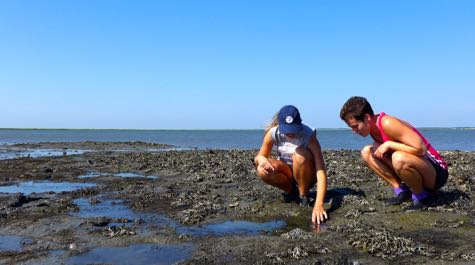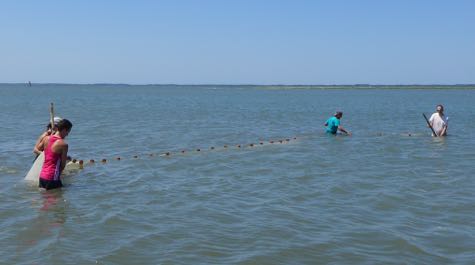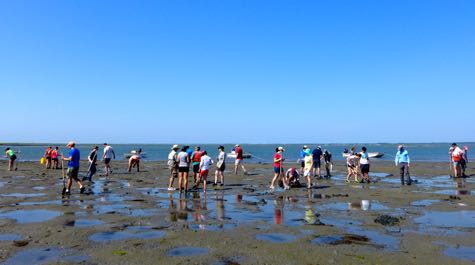New graduate school class begins studies at VIMS
The Virginia Institute of Marine Science officially welcomed 22 new graduate students to its Gloucester Point campus earlier this month. The new class brings enrollment in William & Mary’s School of Marine Science at VIMS to 91 students.
After careful selection by faculty mentors, the incoming class consists of 15 master’s students and 7 doctoral students. Of the 22 students, 5 come from Virginia, 16 are from out of state, and 1 hails from China.
 “Our incoming students are an academically distinguished group and most have already gained considerable research experience as undergraduates, in master’s programs at VIMS or other institutions, or as researchers in various job sectors,” says Professor Linda Schaffner, Associate Dean of Academic Studies at VIMS. “Some have gained valuable experience working within federal science agencies, the U.S. military, or in the private sector.”
“Our incoming students are an academically distinguished group and most have already gained considerable research experience as undergraduates, in master’s programs at VIMS or other institutions, or as researchers in various job sectors,” says Professor Linda Schaffner, Associate Dean of Academic Studies at VIMS. “Some have gained valuable experience working within federal science agencies, the U.S. military, or in the private sector.”
Class members include Justin Shawler, a planning commissioner for the City of Williamsburg; Lydia Bienlien, a three-time Academic All-American in soccer and track and field; James Gartland, a winner of the Award of Excellence from the Atlantic States Marine Fisheries Commission; and NOAA Hollings Scholar Kate Bemis.
“This infusion of new talent will benefit VIMS, the Commonwealth, and the nation as we work together to find better solutions for the problems facing our marine and estuarine systems,” says Schaffner.
A wealth of undergraduate and research experience
- Mar Arroyo arrives from the University of Miami where, beyond being a research and teaching assistant, he participated in 6 research cruises for a total of 57 days at sea.
- Kristen Bachand spent summer 2015 as a Research Experience for Undergraduates (REU) student at VIMS, which played a major role in her choice to enter the graduate program after finishing her undergraduate studies at Brown University. “I look forward to studying how to use my research skills to help protect the marine environment,” says Bachand. “I know so much information about these ecosystems, but still know so little about putting this knowledge into practice. I really feel that VIMS will allow me to do this.”
- Kate Bemis distinguished herself at Cornell University as the first author of an article in the journal Copeia. Her NOAA Hollings Undergraduate scholarship allowed her to work at the National Systematics Laboratory, where she edited a 450+ page monograph on Fishes of the Western North Atlantic. Bemis has received a National Science Foundation Graduate Research Fellowship for her studies at VIMS.
- John “Jack” Conroy was a member of the James Monroe Scholar program at William & Mary, which honors outstanding academic performance. He participated as an undergraduate member of the VIMS team on their research cruise to the Palmer Station Antarctica Long-Term Ecological Research station during winter 2014.
- James DelBene worked as a staff biologist at Perennial Environmental Services in Texas from 2014 to 2016. During his undergraduate career at Hope College in Michigan, he served as a shark biology intern at the Mote Marine Lab in Florida. DelBene will work alongside researchers in the Center for Coastal Resources Management during his studies at VIMS.
- Samantha Fortin, a graduate of Eckerd College, was an REU intern with the Roberts Lab of Ecosystem Ecology and Biogeochemistry at the Louisiana Universities Marine Consortium. At Eckerd, Fortin was a research assistant who studied sponges and corals at sites across Florida.
- Jaclyn Friedman, a graduate of the University of Rhode Island, sailed as a student researcher during a SEA Semester Transatlantic voyage in 2014. At VIMS, she will work with the Aquatic Health Sciences and Physical Sciences departments to study how harmful algal blooms impact the carbon cycle in Chesapeake Bay. “Being accepted to work on a joint supervision project, involving two different labs from different departments, was such an incredible feeling,” says Friedman.
- Douglas Jensen served as a Communication and Information Officer in the United States Air Force from 2008 until 2015. He is a graduate of both the University of Wisconsin and Trident University, where he earned an MBA.
- Addison Ochs was one of the first graduates of the Marine Biology program at Southern Arkansas University, the only one of its kind in Arkansas. There he earned numerous academic awards and presented at the National Collegiate Honors Council in 2014.
- David Perkey has worked as a scientist for the U.S. Army Corps of Engineers in Vicksburg, Mississippi since 2008. He is a graduate of the University of South Carolina, and received his master’s degree from North Carolina State University.
- Kate Ritter is pursuing her master’s degree after working at VIMS’ Aquaculture Genetics and Breeding Technology Center since 2007, where she gained expertise in using flow cytometry to study oysters. “I love the work that ABC does, and I want to be more helpful to its cause, so getting my master’s degree is the next logical step in the progression of my career,” says Ritter.
- Clara Robison conducted research with her undergraduate advisor at the University of North Florida on the effects the Deepwater Horizon oil spill had on fish populations along the Gulf of Mexico coastline.
- Nathalie Schieder began her master’s studies at VIMS during the Spring 2015 semester. She is working to better understand how marshes adapt to coastal inundation.
- Justin Shawler was a member of VIMS’ 2015 REU class during his undergraduate studies at William & Mary. He will continue to serve as a Planning Commissioner for the City of Williamsburg.
- Briana Stanley was a member of VIMS’ 2015 REU class, following an earlier REU stint with the Smithsonian Environmental Research Center in Edgewater, MD. Stanley is a graduate of Washington State University.
- Jessica Turner was a member of three oceanographic cruises in the Gulf of Alaska while a graduate student at the University of Alaska. “Although I studied similar processes in Alaska for my master’s, the York River Estuary is a completely different environment and I’m excited to get a new context,” says Turner.
- Xin Yu comes to VIMS from China, where she completed graduate studies at Nanjing University. Yu participated in a project funded by the National Science Foundation of China to study water quality in the Yalu River estuary, and presented results at the Fourth Forum of Young Marine Scientists hosted by the Chinese Society of Oceanography.
Moving on up
A number of matriculating students earned their master’s degree at VIMS and will now continue in Gloucester Point with pursuit of a doctoral degree.
- Lydia Bienlein is a previous VIMS Fellowship recipient, and won VIMS’ inaugural Three Minute Thesis® contest in 2014.
- James Gartland first arrived at VIMS in 1999 to pursue his master’s. He has since worked in the Department of Fisheries Science as an Assistant Research Scientist, where he has served in several advisory roles and helped to earn and implement 24 grant-funded projects. “Given my long-standing history at VIMS, it only made sense for me to complete my Ph.D. program here,” says Gartland.
- Christian Hauser worked as a scientist at a large consulting firm after receiving his master’s from VIMS in 2010. Hauser now plans to study restoration ecology. “Researchers at VIMS are at the forefront of advancing our understanding of the best approaches to restore ecosystem services provided by coastal systems,” says Hauser.
- Sarah Pease has received two VIMS Foundation Fellowships, as well as a Virginia Sea Grant Graduate Research Fellowship.
- Cassidy Peterson earned a number of graduate awards and honors, and now adds the Kathleen & Robert Roper, Jr. Fellowship at VIMS to the list. “I’m excited about using mathematical and statistical models to advance our understanding of sharks,” says Peterson.
The School of Marine Science at VIMS
 The School of Marine Science at VIMS is one of five graduate and professional schools at William & Mary. The program awarded its first master’s degree in 1943, its first Ph.D. in 1968, and more than 1,000 degrees total. Graduate studies and research opportunities are offered in marine science, oceanography, fisheries and marine policy.
The School of Marine Science at VIMS is one of five graduate and professional schools at William & Mary. The program awarded its first master’s degree in 1943, its first Ph.D. in 1968, and more than 1,000 degrees total. Graduate studies and research opportunities are offered in marine science, oceanography, fisheries and marine policy.
VIMS graduates occupy leading roles in academia, government, and industry. VIMS grads head up the Pacific Salmon Commission, the University of Maryland Center of Environmental Science, and one of the leading environmental consulting and engineering firms in the northeastern U.S., among many other leadership positions.







